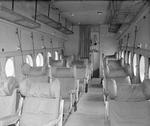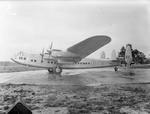York
| Country | United Kingdom |
| Manufacturer | A. V. Roe & Company |
| Primary Role | Transport |
| Maiden Flight | 5 July 1942 |
Contributor: Alan Chanter
ww2dbaseOne of the wartime agreements concluded between Britain and the United States allocated to the Americans responsibility for building all transport aircraft for Allied use, thereby enabling the British aircraft industry to concentrate on fighters and bomber production. Despite this, at Avro's Chadderton factory, in February 1942, designer Roy Chadwick (1893-1947) and his team completed the drawings for a four-engined long-range transport. This design united the wings, tail assembly, engines and landing gear of the Lancaster bomber with a new square section fuselage optimised for the transport role.
ww2dbaseShortly before the first Type 685 York prototype flew at Ringway, Manchester, England, United Kingdom on 5 July 1942, an official order was placed for four aircraft, the first two to have Rolls-Royce Merlin XX engines and the others Bristol Hercules VI radial engines. All four were, in fact, ultimately flown with Merlin engines. A sole Hercules-powered aircraft being the prototype which was re-engined with Hercules XVI units late in 1943 to become the York C Mk. II. To compensate for the additional side area forward of the centre of gravity, a central third fin was added from the third aircraft, named Ascalon, that was one of two VIP York aircraft (MW100 and MW 101) delivered to No. 24 Squadron at RAF Northolt in March 1943 and which were equipped as a flying conference room, principally for the use of Prime Minister Winston Churchill. In total these aircraft would cover in excess of 500,000 miles taking the Prime Minister to Algiers in May and, just a few days later, King George VI used it for his visit to troops in North Africa.
ww2dbaseProduction of the York C. Mk. I built up slowly, first at Ringway but later moving to Yeadon from October 1945. Other VIP-configured York aircraft would include those allocated for official duties to Lord Louis Mountbatten, Field Marshal Jan Smuts and Prince Henry the Duke of Gloucester (Governor-General of Australia from 1944). Five aircraft were also delivered to BOAC for the operation of a UK-Morocco-Cairo service from April 1944, and a further twenty-five were delivered from August 1945 for joint operation with RAF Transport Command, These machines being configured to carry freight in the forward section and twelve passengers aft.
ww2dbaseDuring 1945 No. 511 Squadron at RAF Lyneham became the first to receive a full complement of York aircraft and eventually 10 RAF squadrons would be equipped with this aircraft. Seven of these squadrons being fully operational in time to take part in the Berlin Airlift from 1 July 1948. Production of Avro York aircraft ceased with the delivery of the 257th aircraft to RAF Honington on 29 April 1948. 258 aircraft, including 4 prototypes, were built between 1943 and 1948. The total production run consisted the four prototypes, 208 aircraft for the Royal Air Force, and 45 civilian aircraft, powered by 1,620-hp Merlin 502 engines. The civilian machines consisted of twenty-five for BOAC, twelve for British South American Airways Corporation, five for FAMA of Argentina and two for Skyways Ltd; one additional York was built in Canada by Victory Aircraft.
ww2dbaseYork aircraft were produced in three variants; all-passenger, all freight and mixed passenger/freight. When superseded by Handley Page Hastings transports in RAF Transport Command service, some York aircraft would continue in their accustomed roles, being operated by civilian firms with government contracts for troop-carrying flights. The last York in service with the RAF was Ascalon II, which remained with the Far East Air Force Communication Squadron at Changi, Singapore until 1957.
ww2dbaseSources:
David Mondey: British Aircraft of World War II (Chancellor Press, 1994)
World Aircraft Information Files, File 889/09 (Aerospace Publishing Periodical)
Last Major Revision: Jul 2020
York Timeline
| 5 Jul 1942 | Avro York aircraft took its maiden flight at Manchester, England, United Kingdom. |
| 29 Apr 1948 | Production of Avro York aircraft ceased. |
| 1 Jul 1948 | Avro York aircraft began participating in the Berlin Airlift. |
SPECIFICATIONS
Avro
| Machinery | Four Rolls Royce Merlin T24 V-12 piston engines rated at 1,620hp |
| Armament | None; 24 passengers or 10,000lb of cargo |
| Crew | 4 |
| Span | 31.09 m |
| Length | 23.93 m |
| Height | 5.44 m |
| Wing Area | 120.49 m² |
| Weight, Empty | 19,069 kg |
| Weight, Loaded | 31,115 kg |
| Speed, Maximum | 480 km/h |
| Speed, Cruising | 338 km/h |
| Service Ceiling | 7,010 m |
| Range, Normal | 4,345 km |
Photographs
 |  |  |  |
Please consider supporting us on Patreon. Even $1 per month will go a long way! Thank you. Please help us spread the word: Stay updated with WW2DB: |
- » US Government Plans to Purge WW2 Information (17 Mar 2025)
- » WW2DB's 20th Anniversary (29 Dec 2024)
- » Wreck of USS Edsall Found (14 Nov 2024)
- » See all news
- » 1,166 biographies
- » 337 events
- » 44,601 timeline entries
- » 1,243 ships
- » 350 aircraft models
- » 207 vehicle models
- » 376 weapon models
- » 123 historical documents
- » 261 facilities
- » 470 book reviews
- » 28,551 photos
- » 375 maps
Chiang Kaishek, 31 Jul 1937
Please consider supporting us on Patreon. Even $1 a month will go a long way. Thank you!
Or, please support us by purchasing some WW2DB merchandise at TeeSpring, Thank you!